Before processing city fruit, you'll need to verify it hasn't been chemically treated and guarantee you've correctly identified the species. Always get permission when harvesting from private property and check local foraging regulations. Thoroughly wash fruits using a vinegar-water solution to remove pollutants, and inspect for damage or contamination. Only select ripe, healthy specimens and properly store them in breathable containers. These precautions will transform your urban harvest from potentially risky to deliciously rewarding.
What Should Foragers Know Before Processing City Fruit?
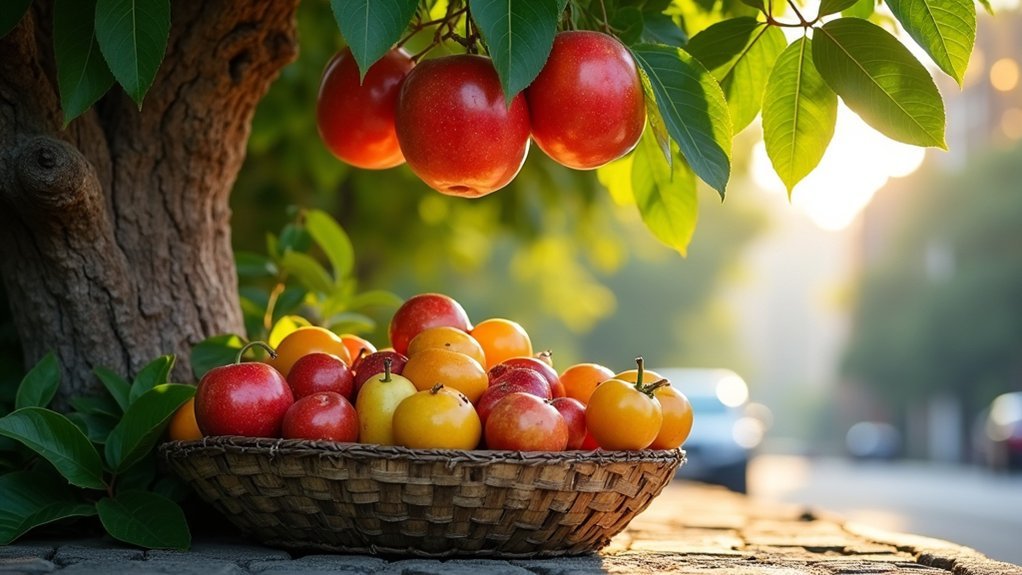
While urban fruit trees offer an abundant and free food source, harvesting them requires careful consideration of several safety factors.
Before foraging city fruit, you'll need to verify that trees haven't been exposed to chemical treatments or pollution, as urban environments often contain heavy metals and other contaminants that can accumulate in produce.
Urban fruit may harbor invisible toxins from city pollution—always research a tree's exposure before harvesting.
Always thoroughly wash your harvest in clean water to remove surface residues before processing.
Proper identification is critical—some urban fruits resemble toxic species, so develop your identification skills to avoid dangerous mistakes.
Check local regulations regarding public space foraging, as many cities restrict harvesting from parks or street trees.
Finally, timing matters in the local environment; understand seasonal patterns to collect fruit at peak ripeness for the best processing results.
Identifying Safe Versus Toxic Urban Fruit Species
Correctly identifying edible fruits represents the cornerstone of safe urban foraging. Common safe species in your local food landscape include apple, plum, and mulberry trees, which offer nutritious harvests throughout various seasons.
Always be vigilant about toxic look-alikes such as poison hemlock, which can appear similar to edible plants but pose serious health risks.
Remember that even with safe species, certain parts may be harmful—cherry pits contain cyanogenic compounds you should avoid consuming.
Before collecting, verify your identification using multiple reliable resources and learn which parts of each plant are safe to eat.
Thoroughly wash all foraged fruits to remove urban contaminants from roadways or pesticides.
Check your city's regulations regarding foraging, as local ordinances may restrict harvesting in some areas or protect certain species.
Washing Techniques to Remove Urban Pollutants
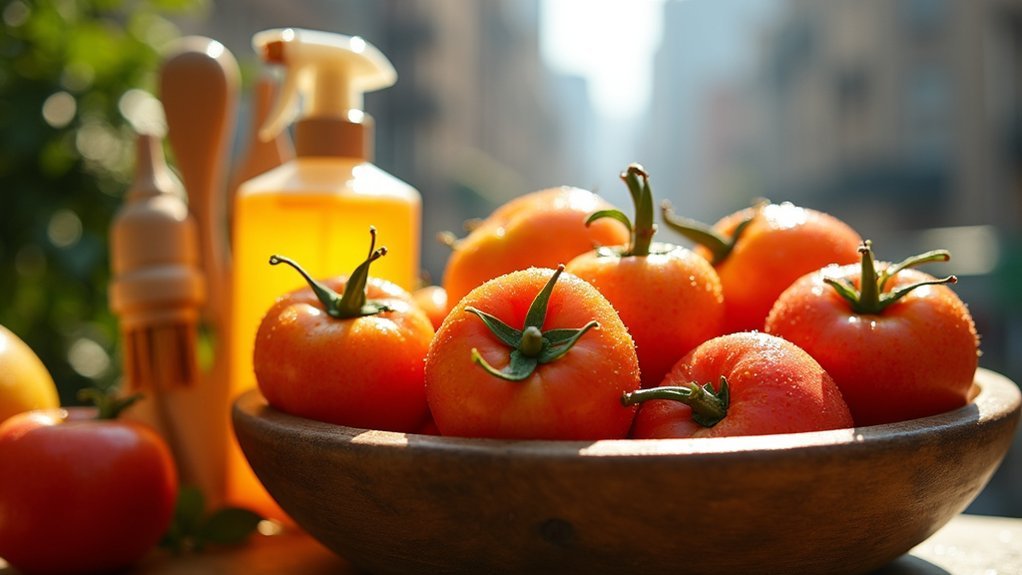
Because city-grown fruits encounter various environmental pollutants, proper washing techniques are essential before consumption. Start by rinsing your urban foraged bounty under cold running water to remove surface contaminants like dust and dirt.
For more thorough cleaning, soak fruits in a solution of 1 part vinegar to 3 parts water for 10-15 minutes, which helps eliminate residual pesticides and pathogens.
For firmer fruits like apples or pears, use a soft brush to scrub away stubborn residues, especially if they were collected near roads or industrial areas. This extra step helps minimize heavy metal exposure.
After washing, dry your fruits completely with a clean towel or let them air dry naturally. Proper drying prevents moisture buildup that could lead to bacterial growth during storage.
Testing for Chemical Contaminants on Foraged Fruits
Washing your urban harvest addresses surface contamination, but knowing what's actually in your foraged fruits provides another layer of safety. To fully assess chemical contamination risks, consider sending samples to local laboratories that specialize in food testing. This investment offers peace of mind, especially when foraging from unfamiliar areas.
Before harvesting, research the site's history to identify potential industrial pollution sources or past land use that might introduce heavy metals like lead or cadmium into the soil.
Remember that plants typically don't absorb most contaminants directly—the greater risk comes from residual soil and dust on your harvest.
Community gardens often maintain testing records, making them reliable foraging resources.
For independent foraging, prioritize locations away from busy roads and industrial zones, and consider purchasing a basic soil testing kit as an accessible screening method.
Understanding Legal Rights for Urban Fruit Collection
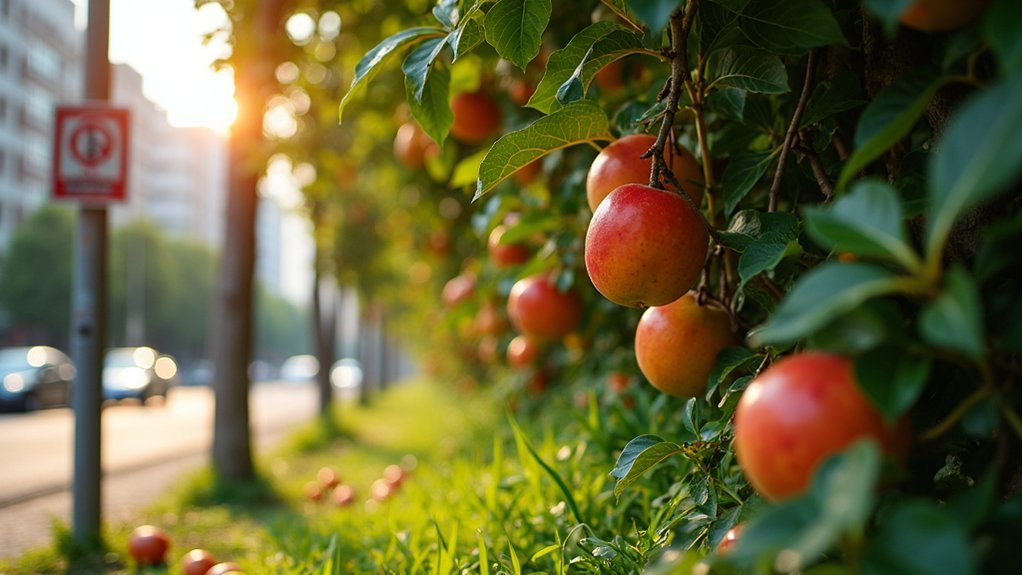
You'll need to navigate the complex boundaries of legal foraging by distinguishing between public and private fruit sources in your urban environment.
Always seek permission before harvesting from private property, as trespassing laws apply even when fruit hangs over public spaces in many jurisdictions.
Check with your local council about designated public fruit trees and community gardens where you're explicitly allowed to collect nature's bounty without legal concerns.
Legal Foraging Boundaries
While the abundant fruit hanging over public sidewalks may seem like nature's free buffet, traversing the legal landscape of urban foraging requires careful consideration.
Before reaching for that tempting apple, understand that legal foraging boundaries vary greatly across jurisdictions.
Fruit from branches extending over public pathways is generally acceptable to harvest, but stepping onto private property without permission crosses into illegal territory.
Your best approach is researching location-specific regulations—Sweden and Scotland offer more generous foraging rights than most urban areas.
Check with your local council about designated foraging zones or community gardens where harvesting is explicitly permitted.
Public parks may allow limited foraging, but restrictions often apply.
Building relationships with property owners can also grant you legitimate access to otherwise off-limits fruit, creating win-win scenarios for your foraging adventures.
Permission vs. Public Access
Understanding where you can legally forage creates the foundation for ethical urban fruit collection.
Always obtain permission before harvesting from private property, even when branches extend into public spaces. This respectful approach builds community trust and keeps you on the right side of the law.
Public parks often provide legal foraging opportunities, but don't assume all city green spaces allow harvesting.
Check local ordinances first, as many cities have specific regulations limiting fruit collection. While overhanging branches into public areas might seem accessible, local property rights laws can vary greatly.
Consider engaging with community groups and local councils to identify approved foraging locations.
These connections can guide you toward permitted areas and help establish positive relationships with landowners who might otherwise view your activities with suspicion.
Know Your Rights
Legal boundaries surrounding urban foraging often create confusion for even experienced fruit hunters. Before you collect that ripe fruit from a neighborhood tree, understand that regulations vary considerably by location. You must distinguish between public and private property—gathering from a local park typically differs from harvesting branches extending over a fence.
| Location Type | Usually Permitted | Usually Prohibited | Check First |
|---|---|---|---|
| Public Parks | Fallen fruit | Damaging trees | Quantity limits |
| Street Trees | Hand-picked fruit | Branch cutting | Local ordinances |
| Private Property | Nothing without permission | Everything | Owner consent |
| Natural Areas | Common species | Protected plants | Conservation rules |
While places like Sweden embrace "right to roam" principles, most urban areas have specific restrictions. Research your city's ordinances before foraging as well, since violations could result in fines or other penalties.
Ecological Impact of Harvesting City Fruit

When you collect fruit from urban trees, you're participating in an ecological system that extends beyond simple food gathering. Your foraging efforts can actually benefit the environment by preventing food waste from fruit that would otherwise fall and rot.
However, practicing common sense is essential—always leave some wild food for wildlife and other foragers. Responsible harvesting creates a positive ripple effect in urban ecology.
Leave enough for creatures who share your habitat—ethical foraging strengthens the web of life around us.
You'll foster biodiversity while simultaneously connecting with local ecosystems. Be mindful not to overharvest, as this can diminish future yields and harm animals that depend on these resources.
Before foraging, consider the health of the surrounding ecosystem. Check soil and water quality to guarantee your harvest isn't negatively impacting the delicate balance of urban nature.
Essential Tools for Safe Urban Fruit Processing
You'll need a reliable Hori-hori shovel-knife and food-safe collection containers to safely harvest and transport urban fruit finds.
Invest in a quality cutting board, sharp knife, and field guide for plant identification to guarantee you're correctly processing only edible species.
Don't forget essential cleaning tools like food-grade buckets for washing and protective equipment such as gloves to maintain hygiene throughout your urban foraging adventure.
Equipment Worth Investing In
Five essential tools can transform your urban fruit foraging from amateur gathering to efficient harvesting.
When you're exploring your neighborhood fruit trees, plants and fungi, a quality knife becomes your most valuable companion, enabling safe and precise cuts that prevent fruit bruising.
Invest in a sturdy fruit peeler for efficiently removing skins from apples and pears, making your foraged bounty more enjoyable.
A food processor or blender proves invaluable for converting excess fruit into sauces or preserves.
If you're serious about extending your harvest's lifespan, canning jars and lids are worth the investment, allowing you to preserve seasonal fruits for months.
Don't overlook a fine mesh strainer—this simple tool guarantees your city-sourced fruit is thoroughly cleaned of contaminants before processing.
Cleaning Process Essentials
Three essential elements define a proper urban fruit cleaning station: clean water, specialized tools, and food-safe sanitizers.
You'll need a reliable water source and a colander or strainer to thoroughly rinse foraged fruit before processing.
A soft brush helps remove surface dirt from apples and cherries, while a sharp knife is vital for trimming contaminated areas or bruised spots.
Always use a dedicated, easy-to-sanitize cutting board to prevent cross-contamination between different fruits.
Don't forget to wear gloves during the cleaning process—they create a barrier that prevents transferring contaminants from your hands to the food.
For sanitizing your equipment and work surfaces, stick with food-safe cleaning products or simple vinegar solutions that disinfect without leaving harmful residues on your urban harvest.
Storage Solutions for Preserving Foraged City Fruit
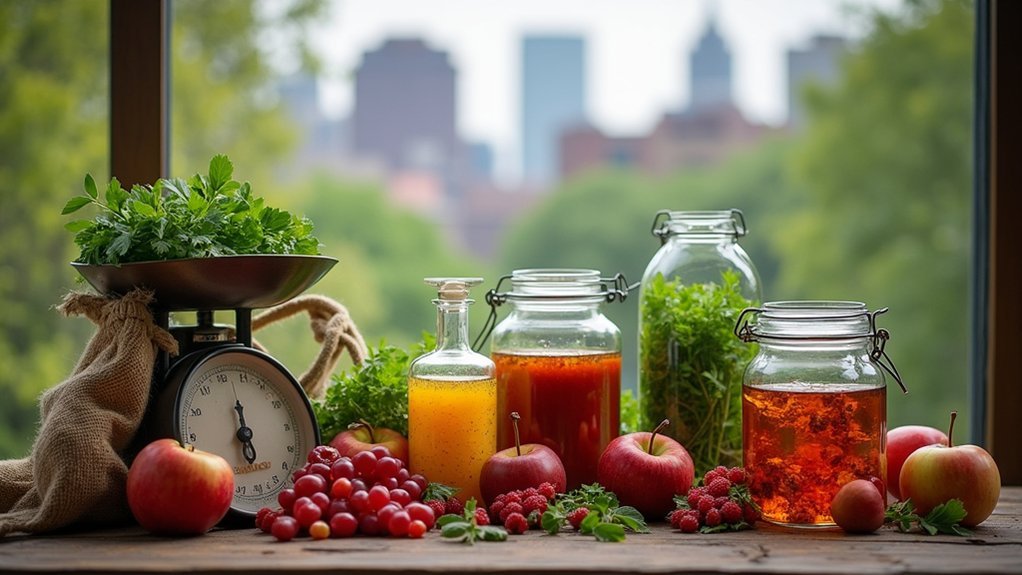
Once you've collected your bounty from urban fruit trees, proper storage becomes essential to maximize freshness and prevent waste.
Choose breathable containers like mesh bags or perforated bins for your foraged fruits to maintain airflow and reduce moisture that can lead to mold.
While refrigeration works best for most finds, keep tomatoes and stone fruits at room temperature to preserve their flavor and texture.
For longer preservation, consider dehydrating or freezing your harvest—dried fruits can last up to a year, while frozen ones remain good for six to twelve months.
Don't forget to label your storage solutions with harvest dates and fruit types.
This simple step helps you track freshness and guarantees you'll use your urban treasures while they're still at peak quality.
Signs of Spoilage and Contamination to Watch For
While proper storage preserves your urban harvest, knowing when fruit has gone bad is equally important for your health and enjoyment. Always inspect city fruit for visible signs of spoilage like discoloration, unusual softness, or mold growth.
If you detect strange or off-putting odors, don't risk consuming the fruit, as these smells often indicate contamination or chemical exposure.
Be wary of fruit growing near busy roads or industrial areas, as these may contain pollutants from vehicle emissions. Similarly, avoid harvesting fruit with pest damage, which not only affects quality but suggests potential exposure to pathogens.
Location matters when foraging; avoid roadside fruit and pest-damaged specimens to minimize exposure to harmful contaminants.
Before processing any urban bounty, thoroughly wash all harvested fruit to remove dust, soil, and surface contaminants. Your vigilance in identifying these warning signs guarantees safer foraging experiences.
Seasonal Foraging Calendar for Urban Environments
As seasons shift through the urban landscape, city foragers discover a changing tapestry of edible offerings waiting to be harvested. Your seasonal foraging calendar should align with local blooming and fruiting cycles, which vary by region.
| Season | Common Wild Finds | Where to Look |
|---|---|---|
| Spring | Edible flowers, greens | Parks, lawns, community gardens |
| Summer | Mulberries, blackberries, raspberries | Fence lines, vacant lots, trail edges |
| Fall | Apples, pears, nuts, persimmons | Public parks, neighborhood trees, urban orchards |
You'll find mulberries ready from late spring through early summer, while blackberries typically peak in July and August. Fall brings a bounty of apples and pears, often found on overhanging branches or in neglected areas. Connect with community gardens for additional harvesting opportunities that follow similar seasonal patterns.
Community Protocols for Sharing Urban Fruit Trees
Urban fruit trees represent a shared resource that flourishes when communities establish clear protocols for harvesting and distribution.
When foraging these wild foods, you'll find greater success by participating in established community initiatives like the Portland Fruit Tree Project, which coordinates surplus fruit collection and equitable sharing.
Before harvesting, notify neighbors about your plans and avoid overharvesting—take only what you need.
Many neighborhoods have developed cooperative agreements that outline maintenance responsibilities and guarantee fair distribution of produce.
Consider joining local food swap events where you can exchange excess harvest with others.
These community protocols transform individual trees valued at millions collectively (as seen in Adelaide) into meaningful food access points while building stronger neighborhood connections and reducing waste.
Converting Urban Fruit Into Preserves and Products
You'll need to thoroughly wash all city fruit harvests before processing to remove urban contaminants that could affect food safety.
Check local regulations about foraging and processing before turning your bounty into preserves, as some public spaces restrict fruit collection.
Consider testing soil for heavy metals in areas with industrial histories, especially if you're creating products to share with others or sell at community markets.
Processing City Harvests
Once you've gathered your urban bounty, transforming foraged fruits into preserves and products requires careful preparation.
Begin by thoroughly washing your harvest to remove contaminants, dust, and pesticides. Unlike commercial wild plants, city fruits may contain urban pollutants requiring extra cleaning for validation purposes.
Accurate identification is essential—some urban fruits have toxic look-alikes.
When making preserves, consider the fruit's acidity and sugar content, as these factors determine preservation methods and shelf life.
Your efforts reduce food waste and create valuable products—Adelaide's backyard fruit trees alone are worth over $1.5 million annually.
Consider participating in local food swaps to exchange your processed goods with others. These community exchanges not only distribute the urban harvest but also foster valuable neighborhood connections.
Fruit Safety Essentials
While enthusiasm for your urban bounty might tempt you to jump straight into preserving, ensuring fruit safety must come first. Thoroughly wash all harvested fruit to remove dust, contaminants, and potential pesticide residues common in urban environments.
Source your fruit from areas free of heavy metal contamination by avoiding industrial sites and busy roadways. Select only ripe, healthy specimens—damaged or overripe fruit can compromise your preserves' quality and safety.
When making preserves, follow proper canning protocols including jar sterilization and maintaining appropriate acidity levels to prevent foodborne illness. These precautions are non-negotiable for safe urban preserves.
Maintain detailed records of your foraging locations and fruit varieties. This practice helps you track safe sources and monitor environmental changes that might affect fruit safety in future harvests.
Frequently Asked Questions
What Are Some Factors That Foragers Consider When Obtaining Their Food?
You consider legality of harvesting, potential contamination risks, ecological impact, fruit ripeness, and community sharing. You'll want to avoid chemical-treated areas and guarantee you're not depleting a fragile plant population.
What Is the 1 3 Rule for Foraging?
The 1-3 rule means you should only harvest one item for every three you leave behind. This sustainable practice guarantees plant populations regenerate, preserves biodiversity, and maintains food sources for wildlife and future foragers.
Is It Safe to Forage in the City?
Yes, you can safely forage in cities if you're cautious about pollution sources. Avoid areas near traffic or industrial sites, wash all finds thoroughly, and research local toxic areas before harvesting. Fruits are generally safer than vegetables.
What Is the First Rule of Foraging?
The first rule of foraging is that you must be 100% confident in your identification of any wild edible before you consume it. Misidentification can lead to serious health risks or poisoning.
In Summary
Urban fruit foraging isn't just about knowing what to pick—it's about harvesting responsibly. You'll need to identify safe species, properly wash away pollutants, and respect property boundaries. When you've mastered these skills, you're not just gathering food; you're connecting with your city's hidden abundance. By following proper protocols, you're transforming overlooked resources into sustainable nourishment while building community through shared harvests.

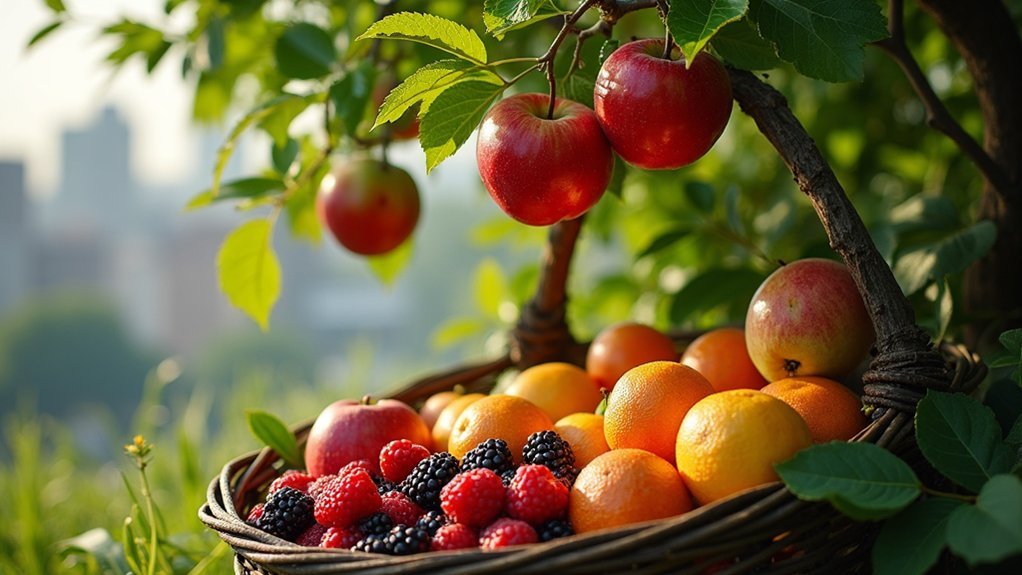



Leave a Reply